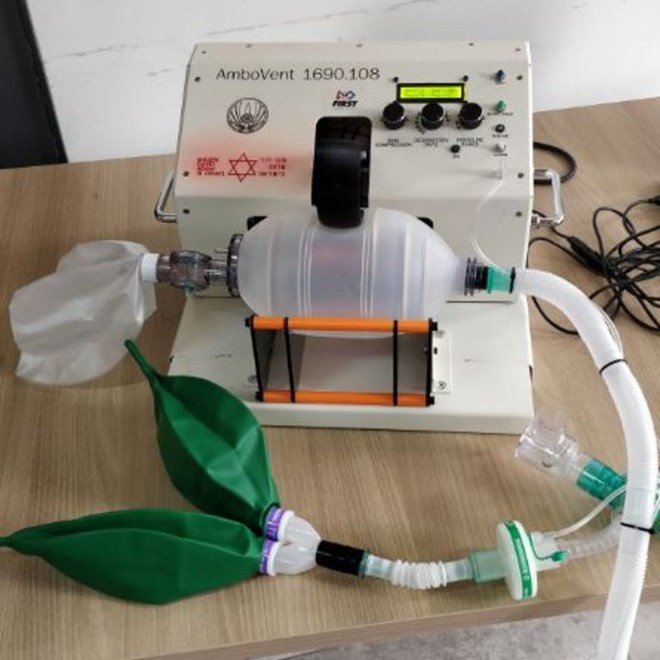
Sunday April 26, 2020
By Thomas Mulier

AmboVent ventilator (photo credit: COURTESY MDA)
As hospitals scour their storerooms in search of ventilators for Covid-19 patients, Israeli inventors have proposed a solution: an open-source, build-it-yourself breathing machine that costs less than $500.
Called AmboVent, it’s the brainchild of a team led by David Alkaher, a 40-year-old engineer with the Israeli Air Force. Based on simple components that are easy to find like windshield-wiper motors, the device has a price advantage over full-scale models: High-end ventilators made by the likes of Philips can cost almost 100 times as much.
Ventilators have been difficult to find at any price, sometimes forcing doctors in jammed intensive care units to decide who gets the last one available. General Motors Co. was ordered last month by U.S. President Donald Trump to make the breathing machines to help fill the gap, and announced preparations for deliveries last week.
“We are in a race,” said Eitan Eliram, a tech entrepreneur who’s managing the project alongside Yuval Eran, a paramedic who mentors children on robotics. “Corona taught us something: Let’s move fast.”
newsinsiOther efforts to raise access to the devices include the Massachusetts Institute of Technology’s E-Vent and the Pandemic Ventilator Project. The need is crucial: countries such as Liberia, South Sudan and the Central African Republic have only a handful of ventilators. Somalia doesn’t have any. The U.S. has put in orders for more than 187,000 this year.
‘Compassion Device’
AmboVent uses a simple robot arm to compress an Ambu bag -- a football-shaped balloon that first responders normally use to assist breathing -- to force air through a tube into patients’ lungs. While potentially life-saving, “it’s a second-choice compassion device,” Eliram said. “This is your plan B in the hospital, once you’ve exhausted all your $40,000 machines.”
On April 1, Alkaher’s team published the design for the AmboVent-1690-108 on the online forum GitHub, allowing anyone to take the idea and run with it. With 40 volunteers, AmboVent is busy producing 20 prototypes on a shoestring budget of $200,000, planning to send them to various countries where other developers will navigate the process of getting regulatory approval. The team also has links to a local hacking venture organized by Microsoft Corp. and First, a non-profit that promotes robotic engineering for children.
An advantage of the design is that it’s based on components that are easy to obtain, said Essen Davis, a 42-year-old paramedic in Detroit who’s given feedback to AmboVent’s designers. Ventilators need to measure humidity, air temperature, pressure and flow to work effectively.
“There are a lot of puzzles to be overcome,” Davis said. “We’re close, but we’re not 100% there. Whether we’ll be able to do it in time to help a lot of people -- that’s the million-dollar question.”
AmboVent’s blueprints have been downloaded more than 40,000 times and some 300 teams in locations from Alaska to Ukraine have expressed interest, Eliram said. His group registered Sunday as a nonprofit organization in Israel and is starting a crowdfunding campaign this week on CauseMatch to pay a full-time staff.

The AmboVent Source: AmboVent
Little Testing
The big question will be whether regulators approve the device. One of the few tests on it so far was conducted on a pig at Hadassah-Hebrew University Medical Center in Jerusalem.
While praising the effort, Frans van Houten, the chief executive officer of Philips, expressed some doubt about the low-cost competition.
“It’s hard to imagine that all these initiatives will result in a critical-care ventilator that is approved by the regulators and safe to use,” he said in an interview.
Philips’ ventilators control the delivery of oxygen to patients using more than a million lines of software code, Van Houten said. The Dutch company is investing more than 100 million euros ($109 million) to add five production lines and ramp up manufacturing, and also introduced a less expensive model. Typically the cheapest ventilators cost about 3,500 euros, he said.
AmboVent does have a smart card that allows programmers to regulate its speed, and can link to smartphone apps that allows doctors to quickly determine which patient in a ward most needs attention.
“Maybe it doesn’t look as pretty,” said Davis, the paramedic in Detroit, “but for right now, in a pinch, it’s the best that we’ve got.”